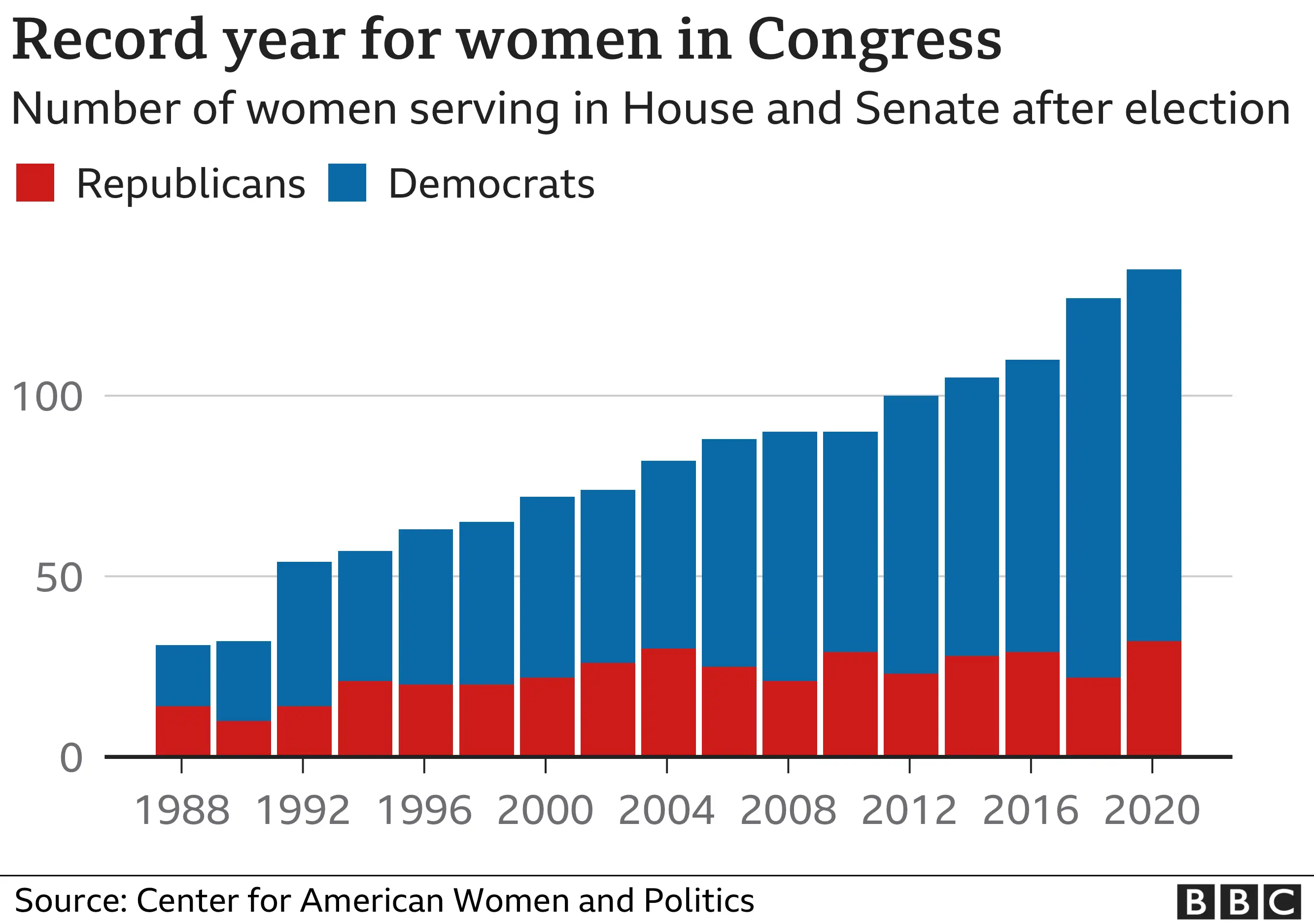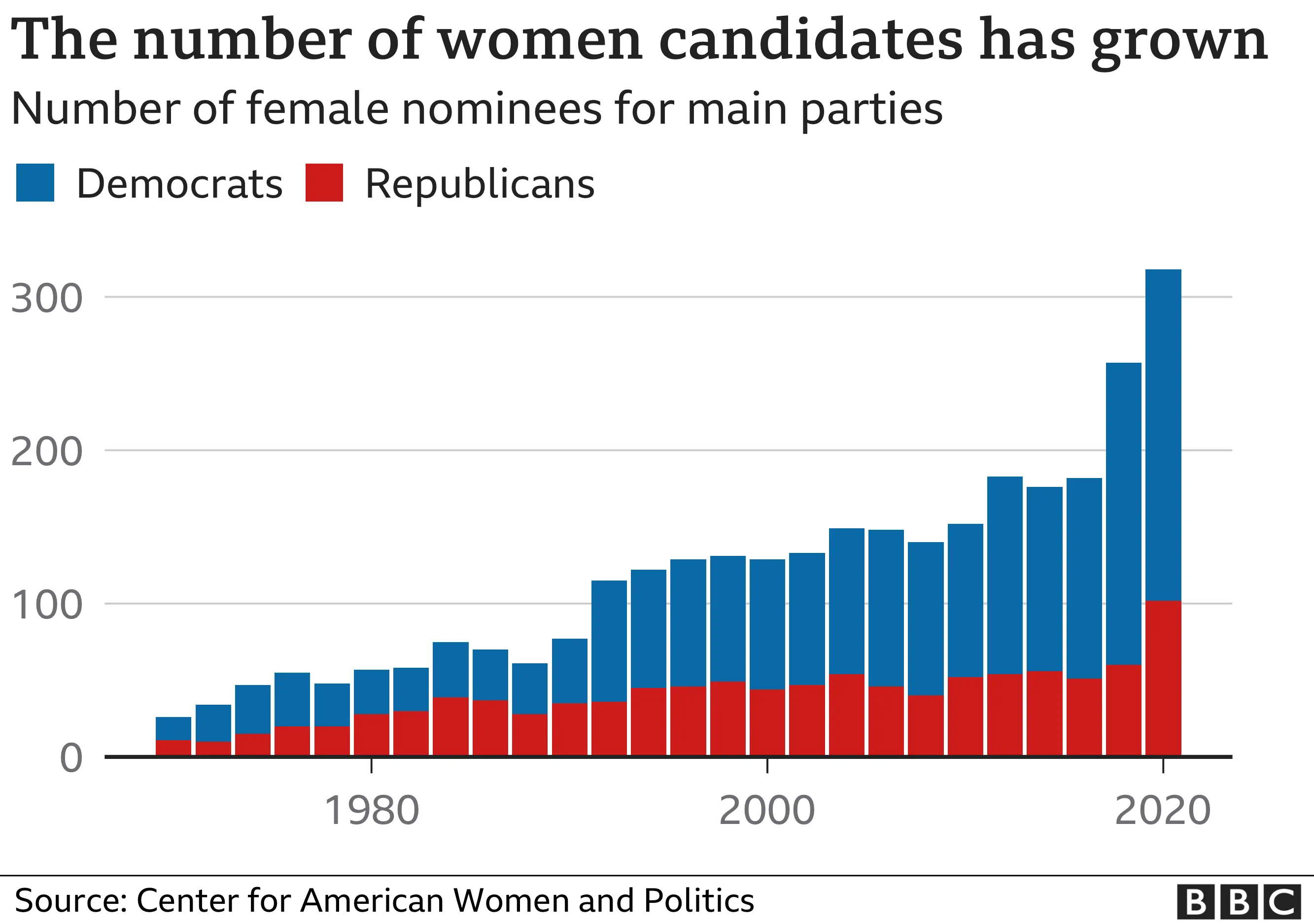Women continue to change the face of US politics
 BBC
BBCMuch of the focus of the US election has been the battle for the presidency between two white men, Donald Trump and Joe Biden.
But the nationwide ballot also saw Kamala Harris set to become the first woman vice-president and a record number of women voted into Congress - the part of the US government that writes and passes laws.
Here's how the numbers break down ahead of Congress's new term at the beginning of next year.
1. At least 135 women will have a say in Congress in 2021
Women, who make up just over half of the US population, currently make up just under a quarter of Congress's two chambers, the House of Representatives and the Senate.
However, when the 117th congressional term begins in January, an unprecedented 135 women, possibly more, will serve across both houses - with 103 Democrats and 32 Republicans voted in so far, according to Rutgers University's Center for American Women and Politics (CAWP).
Women will take up just over a quarter of the 535 seats - 25.2% - up from the current 23.7%.
These totals could rise further, though, with the results of a number of contests still outstanding.

This year's figures are part of a long-running trend towards better representation for women, with most previous Congresses breaking the record that came before - some years more dramatically than others.
Now, for the 15th time in 16 Congresses, the proportion of women across the two chambers will rise.

Republican women have made particular progress this election after struggling to replicate the recent success of the Democrats.
In the mid-term elections in 2018, almost three-quarters of the women running for Congress were Democrats.
But from next year, while there are still more Democrat women than Republican women, the Republican Party will have its highest number of female Congressional representatives ever to serve.
So far 32 Republican women will sit across both houses, according to CAWP, surpassing the party's previous record of 30 in 2004.
They could up their numbers further in some of the outstanding contests. For example, Republican Senator Kelly Loeffler - appointed to the Senate last year to fill a vacant seat - will take on Democrat Raphael Warnock in the January run-off election in Georgia.
In the House of Representatives, the Republicans have almost doubled the number of women - from 13 to 24 - the result of concerted efforts by the party to recruit a more diverse range of candidates.
 Getty Images
Getty ImagesAmong them are 13 "non-incumbent" Republican women - new candidates who do not already hold a seat.
However, the party still trails the Democrats, who are set to have 87 women or more serving from January.
CAWP director Debbie Walsh says the rising numbers are down to "hard work".
"Successes like these don't just happen," she says. "They require the dedicated attention of parties, donors, activists, and voters, as is particularly evident from the expanded number of Republican women candidates this year."
This year's election follows the 2018 mid-terms which saw a surge of women entering Congress for the Democrats, including "The Squad" - the informal name for a group of women elected to the House, made up of Alexandria Ocasio-Cortez of New York, Ilhan Omar of Minnesota, Ayanna Pressley of Massachusetts, and Rashida Tlaib of Michigan.

But while significant progress has been made on the congressional gender balance in the last two years, men still take up almost three quarters of the seats in the House and the Senate.
While there will be 135 women in the two houses next year, there will be 400 men.
"The work continues," says CAWP's Ms Walsh.
2. Among the new representatives are 47 women of colour
As well as seeing increased numbers of women, the 2020 election has also seen women of colour solidify presence in the two chambers.
Overall, 47 lawmakers next year will be non-white women (from black, Hispanic, Asian/Pacific Island and Native American backgrounds) - down one from 48 across the House and the Senate.
All except one ran for the Democrats.

Among this record-breaking intake, will be an unprecedented number of Native American women.
Republican Yvette Herrell, who is Cherokee, beat the Democratic incumbent Xochitl Torres Small in New Mexico, and will join Democrats Deb Haaland, a Laguna Pueblo member representing New Mexico, and Sharice Davids, a Ho-Chunk Nation member representing Kansas, who kept hold of their House of Representatives seats.
The wins for Ms Herrell and Ms Haaland also mean that New Mexico has become the first ever state to elect women of colour as all three of its delegates in the US House.
Allow Instagram content?
But diversity has not just increased inside Congress, it will be improved in the new administration's top team too.
Senator Kamala Harris is set to become the first woman elected to the vice presidency of the US. She is the third woman and the first woman of colour to be nominated by a major party for the position.
3. More women were elected because more stood as candidates
Two years ago, the 2018 mid-terms broke nearly all records in women's major-party nominations for Congress.
And this year women pushed things further still.

An unprecedented 318 women ran as Democratic or Republican candidates - official party nominees - for the 535 seats available across the House and the Senate.
That was up from the previous record of 257 set in 2018.
Of the 318 candidates, a record 117 were women of colour.
Marilyn Strickland, the first black woman to be sent to Congress by Washington state, says more women like her are now feeling comfortable standing as candidates.
"It is exciting to see so many women of colour step up," Ms Strickland told Good Morning America. "I think the more that we see folks running for office, the more that we see people holding office, the more encouraged people are."
In 2018, 234 women were nominees for the House, up more than 40% on the previous high of 167.
This year's election has seen 298 women stand as House candidates, a more modest 27% increase from the record set in 2018.
Of these, 204 women stood for the Democrats, according to CAWP, compared with 182 in 2018, and 94 stood for the Republicans, compared with 52 in 2018.
But while women House candidates increased this year, female Senate candidates fell.
There were just 20 women nominees for the Senate, compared with 23 last year.
Twelve of these stood for the Democrats - down from 15 in 2018 - while eight stood for the Republicans, the same number as in the mid-terms.
4. The newly-elected women are changing the way Congress looks and feels
Across the country there have been a number of historic wins, thrusting a diverse range of women into frontline US politics.
The state of Missouri will send its first woman of colour and first black woman to the US Congress following Cori Bush's victory last week.
The nurse and pastor, who played a high-profile role during anti-police brutality protests in Ferguson in 2014, was elected to the House for the state's first district.
Allow X content?
Washington state will also send its first black woman to Congress.
Marilyn Strickland, the two-time former Democratic mayor of Tacoma, Washington, won her race in Washington's 10th Congressional District.
Allow X content?
And at least two states will send their first Republican women to the House.
Ashley Hinson beat incumbent Democratic Abby Finkenauer in Iowa and Nancy Mace upset Democratic incumbent Joe Cunningham in South Carolina.
Allow X content?
Meanwhile, Wyoming will send its first ever woman to the Senate after Republican Cynthia Lummis beat Democratic opponent Merav Ben-David.
Allow X content?
Yet, despite this year's firsts and record-breaking numbers, women will still make up just over a quarter of Congress in 2021.
Women's representation in American politics has been, through "struggle and persistence" on "a long, if occasionally fitful, upward trajectory", says CAWP 's Debbie Walsh.
And while 2018 was a story of Democratic success and this year has seen gains for the Republicans, she says, advances "must come from both sides of the aisle" if equal representation is to be achieved.
One thing's for sure, though, these newly-elected congresswomen representing both parties will be, from January, helping to shape legislation that will affect generations to come.
Note: Congressional figures include a number of incumbent women senators not up for election in 2020 but do not include Senator Kamala Harris, who ascends to the vice presidency, or non-voting delegates in the House.
Design and graphics by Irene de la Torre Arenas, Sana Jasemi and Mike Hills.
